스프링 시큐리티와 OAuth2.0
스프링 시큐리티란 사용자 “인증” 및 “권한 부여”를 위한 프레임워크입니다. 이를 통해, 특정 URL에 접근을 허가 또는 불허 할 수 있습니다. 요새 많은 서비스에서 로그인 기능을 구글,네이버,카카오톡과 같은 소셜 로그인 기능을 제공합니다. 직접 구현시 모든것을 구현시켜야하다보니 시간과 노력이 커집니다. OAuth 로그인 구현 하게 된다면
- 로그인 시 보안
- 회원가입 시 이메일 혹은 전화번호 인증
- 비밀번호 찾기
- 비밀번호 변경
- 회원정보 변경 이러한 기능을을 모두 맡기고 서비스 개발에 집중 할 수 있습니다.
먼저 구글 서비스 등록을 하는데 이부분은 구글 클라우드 플랫폼(https://console.cloud.google.com/)에 접속해서 순서대로 진행합니다
- 프로젝트 탭 선택후 새 프로젝트 생성을 합니다.
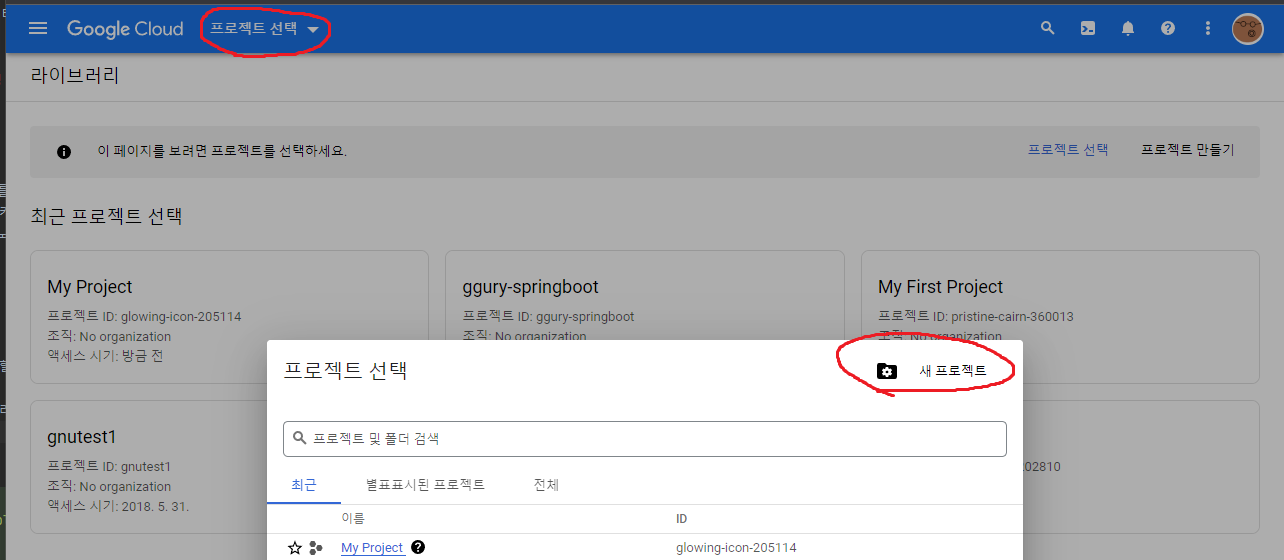
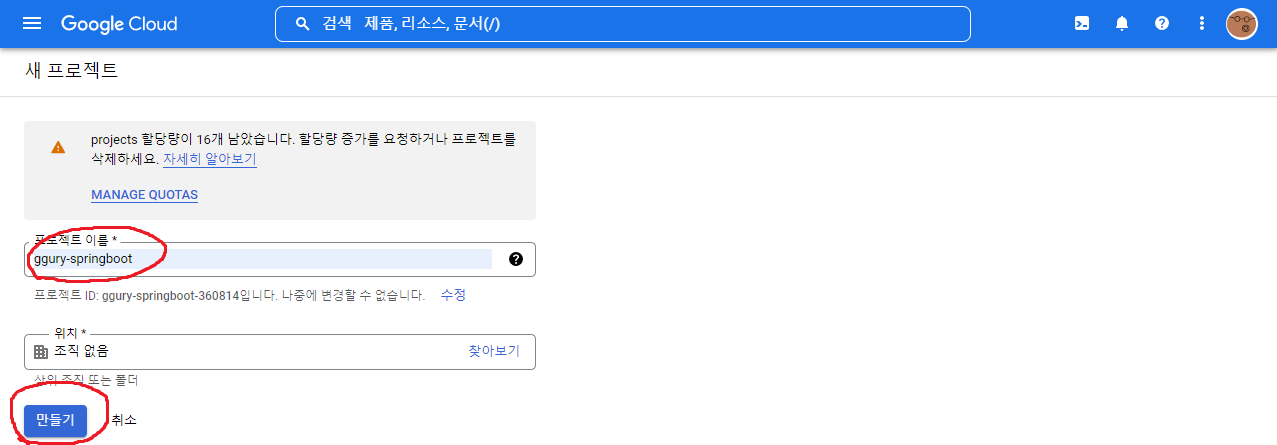
- API 및 서비스 설정:OAuth 동의 화면
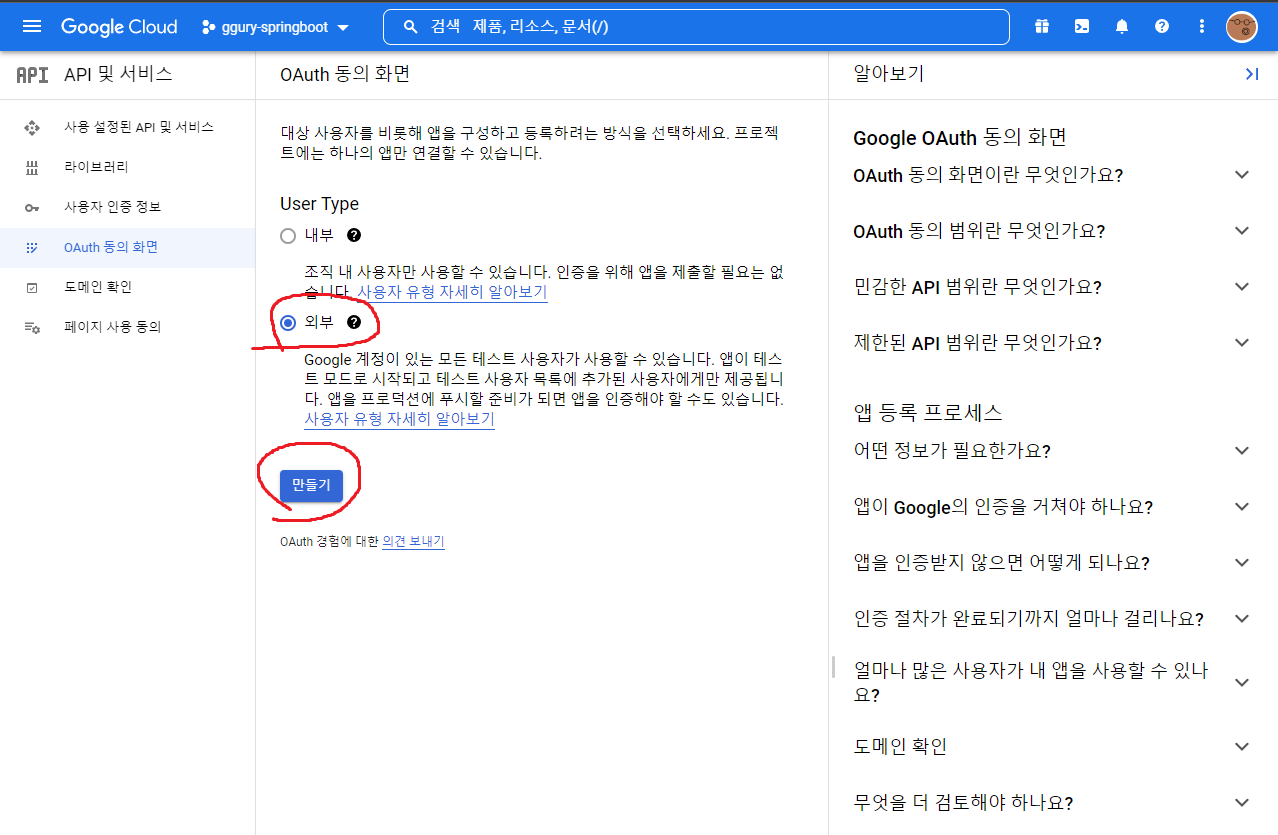
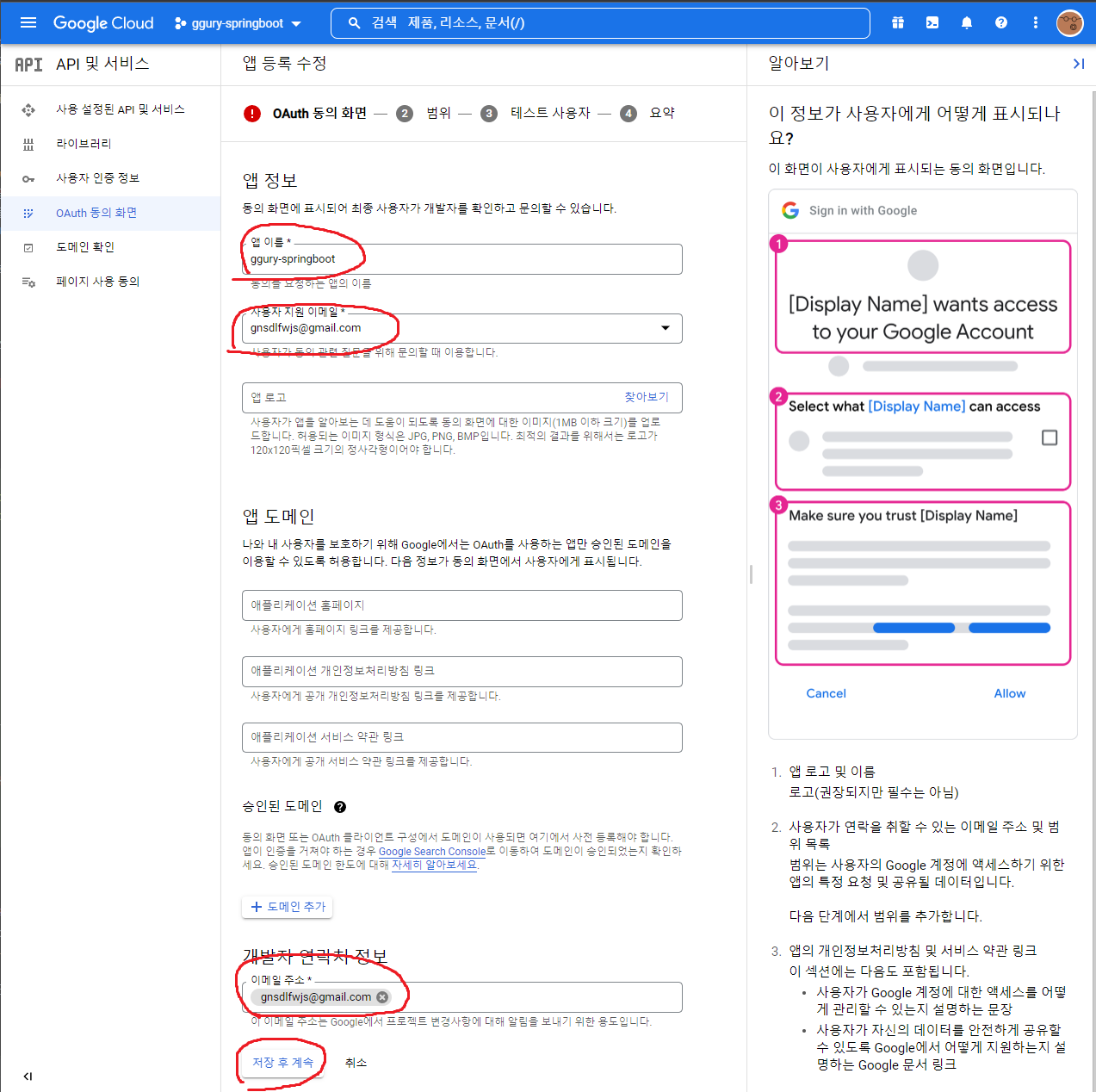
- API 및 서비스 설정: OAuth2.0 클라이언트 ID 만들기화면
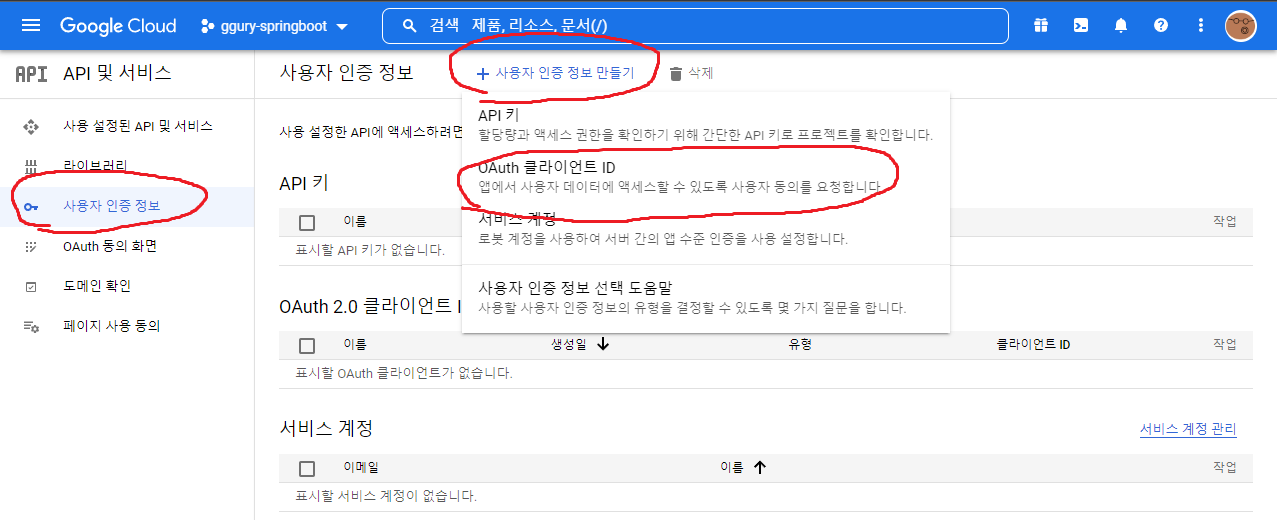
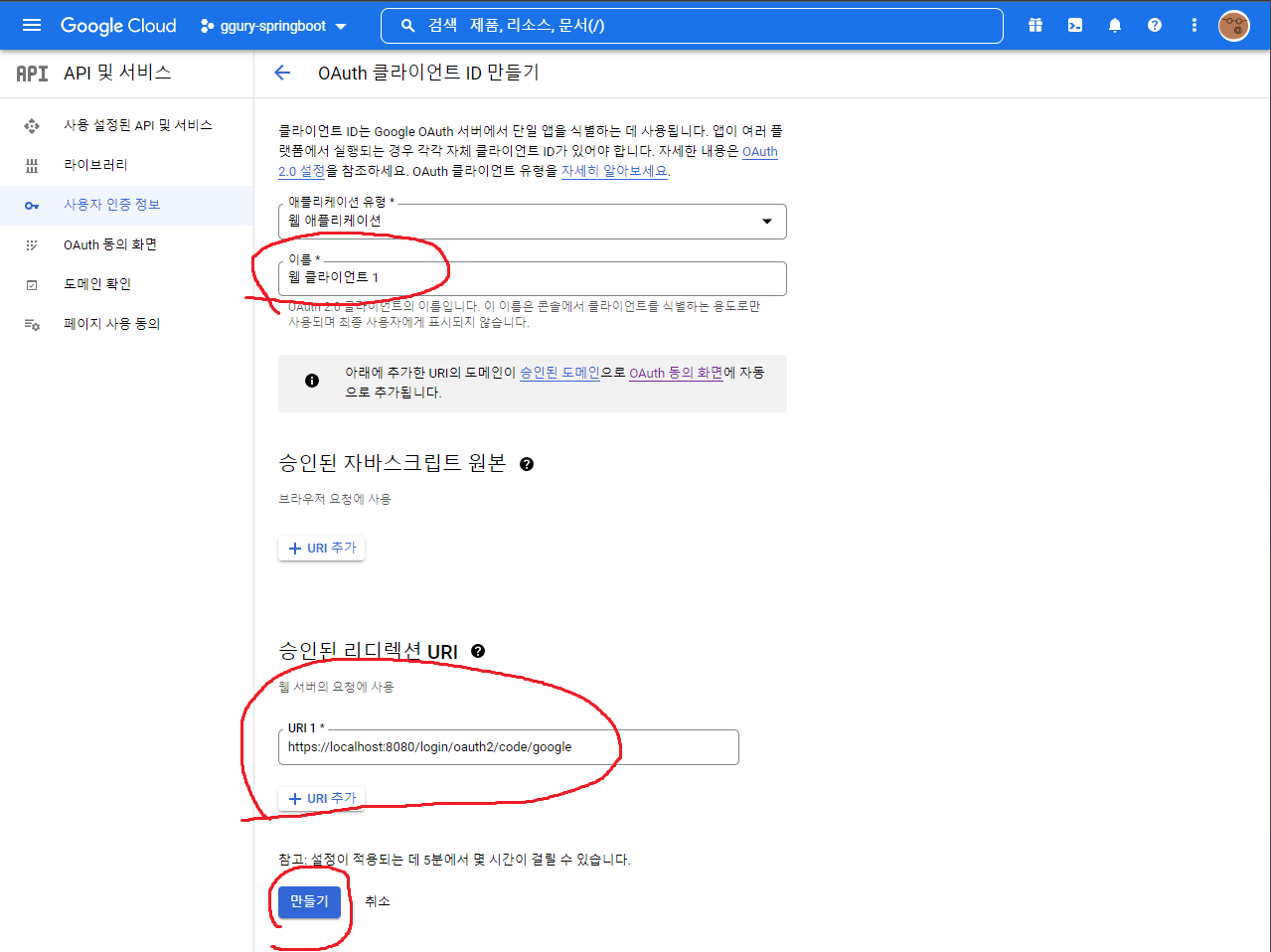
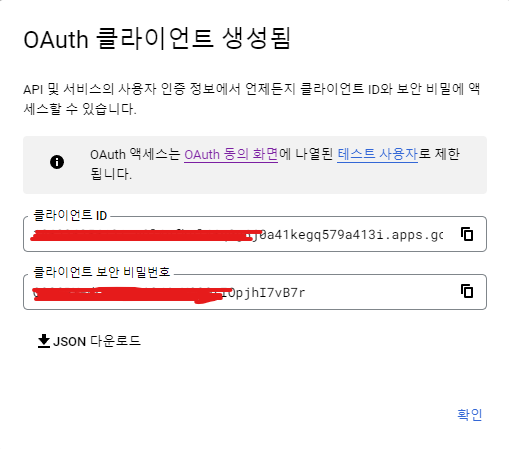
이후 application-oauth.properties 파일 생성후 클라이언트 아이디와 보안 비밀번호 코드를 등록합니다. 여기서 scope-profile,email경우 등록해도 안해도 되지만 등록하는 이유는 openid라는 scope가 있으면 Open Od Provide로 인식하기 때문
이렇게 되면 OpenID Provider인 서비스와 그렇지 않은 서비스(카카오/네이버)등으로 나눠서 OAuth2Service를 만들어야하기 합니다.
그래서 하나의 OAuth2Sevice로 사용하기 위해 일부러 openid scope를 빼고 등록합니다.
여기서 scope-profile,email경우 등록해도 안해도 되지만 등록하는 이유는 openid라는 scope가 있으면 Open Od Provide로 인식하기 때문
이렇게 되면 OpenID Provider인 서비스와 그렇지 않은 서비스(카카오/네이버)등으로 나눠서 OAuth2Service를 만들어야하기 합니다.
그래서 하나의 OAuth2Sevice로 사용하기 위해 일부러 openid scope를 빼고 등록합니다.
스프링 부트에서는 properties의 이름을 application-xxx.properties로 만들면 xxx라는 이름의 profile이 생성되어 이를 관리 할 수 있습니다.
즉,profile=xxx라는 식으로 호출하면 해당 properties의 설정들을 가져올 수 있습니다. application.properties에 spring-profiles.include=oauth 이 코드를 추가 합니다.
그럼 이제 이 설정값을 사용할 수 있습니다.
여기서 중요한점 클라이언트 아이디와 보안 비밀번호는 보안이 중요한 정보입니다. 이들이 외부에 노출되면 개인정보를 가져갈 수 있는 취약점이 될 수 있기에
혹시나 깃과 연동해서 사용중이시라면 .gitignore에 application-oauth.properties 코드를 추가 합니다.

만약 .gitignore에 추가 하였음에더 커밋목록에 노출된다면 git 캐쉬문제이니 해당 폴더에 gitbash를 사용해
- git rm -r —cached .
- git add .
- git commit -m “fixed untracked files” 명령어를 입력해 보시길 바랍니다.
구글 로그인 연동하기
인증정보를 받았으니 프로젝트 구현을 해보겠습니다.
-User-
사용자 정보를 담당할 도메인 User클래스 사용자의 name,picture이 변경되면 User 엔티티에도 반영
package com.ggurys.springbootwebservice.domain.user;
import com.ggurys.springbootwebservice.domain.BaseTimeEntity;
import lombok.Builder;
import lombok.Getter;
import lombok.NoArgsConstructor;
import javax.persistence.*;
@Getter
@NoArgsConstructor
@Entity
public class User extends BaseTimeEntity{
@Id
@GeneratedValue(strategy = GenerationType.IDENTITY)
private Long id;
@Column(nullable = false)
private String name;
@Column(nullable = false)
private String email;
@Column
private String picture;
@Enumerated(EnumType.STRING)
@Column(nullable = false)
private Role role;
@Builder
public User(String name, String email, String picture, Role role) {
this.name = name;
this.email = email;
this.picture = picture;
this.role = role;
}
public User update(String name, String picture) {
this.name = name;
this.picture = picture;
return this;
}
public String getRoleKey() {
return this.role.getKey();
}
}-
Enumerated(EnumType.STRING)
- JPA로 DB 저장할때 Enum값을 어떤 형태로 저장할지 결정합니다.
- default값은 int로된 숫자로 저장
- 숫자로 저장시 DB로 확인시 그 값이 무슨 코드를 의미하는지 알수 없습니다.
- 그래서 무자열(EnumType.String)로 저장 되도록 선언합니다.
-Role-
- 사용자 권한을 관리할 Enum클래스 Role 생성
-
스프링 시큐리티에서는 권한 코드에 항상 ROLE이 앞에 있어야함만 그래서 코드별 키값을 “ROLE****” 등으로 지정
package com.ggurys.springbootwebservice.domain.user;
import lombok.Getter; import lombok.RequiredArgsConstructor;
@Getter @RequiredArgsConstructor public enum Role { GUEST(“ROLEGUEST”, “손님”), USER(“ROLEUSER”, “일반 사용자”);
private final String key;
private final String title;}
## **\-UserRepository-**
User의 CRUD를 책입질 UserRepository 생성
```java
package com.ggurys.springbootwebservice.domain.user;
import org.springframework.data.jpa.repository.JpaRepository;
import java.util.Optional;
public interface UserRepository extends JpaRepository<User,Long> {
Optional<User> findByEmail(String email);
}-스프링 시큐리티 설정-
build.gradle에 compile(‘org.springframework.boot:spring-boot-starter-oauth2-client’) 의존성 추가
-
spring-boot-starter-oauth2-client
- 소셜 로그인 등 클라이언트 입장에서 쇼셜 기능 구현시 필요한 의존성
- spring-securiry-oauth2-client와 spring-securiryoauth2-jose를 기본으로 관리해줍니다
-SecuriryConfig-
OAuth라이어브리를 이용한 쇼셜 로그인 섧정 코드 작성을 하는곳 이며 시큐리티 관련 클래스를 담는곳
package com.ggurys.springbootwebservice.config.auth;
import com.ggurys.springbootwebservice.domain.user.Role;
import lombok.RequiredArgsConstructor;
import org.springframework.security.config.annotation.method.configuration.EnableGlobalMethodSecurity;
import org.springframework.security.config.annotation.web.builders.HttpSecurity;
import org.springframework.security.config.annotation.web.configuration.EnableWebSecurity;
import org.springframework.security.config.annotation.web.configuration.WebSecurityConfigurerAdapter;
@RequiredArgsConstructor
@EnableWebSecurity // 1.
public class SecurityConfig extends WebSecurityConfigurerAdapter {
private final CustomOAuth2UserService customOAuth2UserService;
@Override
protected void configure(HttpSecurity http) throws Exception {
http
.csrf().disable().headers().frameOptions().disable() // 2.
.and()
.authorizeRequests() // 3.
.antMatchers("/", "/view/**", "/css/**", "/images/**", "/js/**", "/h2-console/**", "/profile").permitAll().antMatchers("/api/v1/**").hasRole(Role.USER.name()) // 4.
.anyRequest().authenticated() // 5.
.and()
.logout()
.logoutSuccessUrl("/") // 6.
.and()
.oauth2Login() // 7.
.userInfoEndpoint() // 8.
.userService(customOAuth2UserService); // 9.
}
}-
EnableWebSecurity
- Spring Securiry 설정을 활성화
-
.csrf().disable().headers().frameOptions().disable()
- h2-console 화면을 사용하기 위해 해당옵션을 비활성화
-
authorizeRequests
- URL별 권한 관리를 설정하는 옵션의 시작점
- authorizeRequests가 선언 되어야만 antMatchers옵션을 사용 할 수 있습니다.
-
antMatchers
- 권한 관리 대상을 지정하는 옵션
- URL,HTTP 메소드별로 관리 가능
- ”/“등 지정된 URL들은 permitAll() 옵션을 통해 전체 열람 권한을 부여
- “/api/v1/**” 주소를 가진 API는 USER 권한을 가진 사람만 가능하도록 허용
-
anyRequest
- 설정된 값들 이외 나머지 URL을 나타냅니다.
- 여기서 authenticated()를 추가하여 나머지 URL들은 모두 인증된 사용자들에게만 허용하게 됨
- 즉 로그인한 사용자들을 의미
-
.logoutSuccessUrl(”/“)
- 로그아웃 기능에 대한 여러 설정의 진입점
- 로그아웃 성공 시 ”/” 주소로 이동
-
oauth2Login
- OAuth2 로그인 기능에 대한 여러 설정의 진입점
-
userInfoEndpoint
- OAuth2 로그인 성공 이후 사용자 정보를 가져올 때의 설정들을 담당
-
userService
- 소셜 로그인 성공 시 후속 조치를 진행할 UserService 인터페이스의 구현체를 등록합니다.
- 리소스 서버(쇼셜서비스)에서 사용자 정보를 가져온 상태에서 추가로 진행 하고자하는 기능을 명시할수 있습니다.
-CustomOAuth2UserService-
구글 로그인 이후 가져온 사용자의 정보(email.name,picture )들을 기반으로 가입 및 정보수정, 세션저장등의 기능을 지원
package com.ggurys.springbootwebservice.config.auth;
import com.ggurys.springbootwebservice.config.auth.dto.OAuthAttributes;
import com.ggurys.springbootwebservice.config.auth.dto.SessionUser;
import com.ggurys.springbootwebservice.domain.user.User;
import com.ggurys.springbootwebservice.domain.user.UserRepository;
import lombok.RequiredArgsConstructor;
import org.springframework.security.core.authority.SimpleGrantedAuthority;
import org.springframework.security.oauth2.client.userinfo.DefaultOAuth2UserService;
import org.springframework.security.oauth2.client.userinfo.OAuth2UserRequest;
import org.springframework.security.oauth2.client.userinfo.OAuth2UserService;
import org.springframework.security.oauth2.core.OAuth2AuthenticationException;
import org.springframework.security.oauth2.core.user.DefaultOAuth2User;
import org.springframework.security.oauth2.core.user.OAuth2User;
import org.springframework.stereotype.Service;
import javax.servlet.http.HttpSession;
import java.util.Collections;
@Service
@RequiredArgsConstructor
public class CustomOAuth2UserService implements OAuth2UserService<OAuth2UserRequest, OAuth2User> {
private final UserRepository userRepository;
private final HttpSession httpSession;
@Override
public OAuth2User loadUser(OAuth2UserRequest userRequest) throws OAuth2AuthenticationException {
OAuth2UserService<OAuth2UserRequest, OAuth2User> delegate = new DefaultOAuth2UserService();
OAuth2User oAuth2User = delegate.loadUser(userRequest);
// OAuth2 서비스 id (구글, 카카오, 네이버)
String registrationId = userRequest.getClientRegistration().getRegistrationId(); // 1.
// OAuth2 로그인 진행 시 키가 되는 필드 값(PK)
String userNameAttributeName = userRequest.getClientRegistration().getProviderDetails().getUserInfoEndpoint().getUserNameAttributeName(); // 2.
// OAuth2UserService
OAuthAttributes attributes = OAuthAttributes.of(registrationId, userNameAttributeName, oAuth2User.getAttributes()); // 3.
User user = saveOrUpdate(attributes);
httpSession.setAttribute("user", new SessionUser(user)); // 4. SessionUser (직렬화된 dto 클래스 사용)
return new DefaultOAuth2User(Collections.singleton(new SimpleGrantedAuthority(user.getRoleKey())),
attributes.getAttributes(),
attributes.getNameAttributeKey());
}
// 유저 생성 및 수정 서비스 로직
private User saveOrUpdate(OAuthAttributes attributes){
User user = userRepository.findByEmail(attributes.getEmail())
.map(entity -> entity.update(attributes.getName(), attributes.getPicture()))
.orElse(attributes.toEntity());
return userRepository.save(user);
}
}-
registrationId
- 현재 로그인 진행 중인 서비스를 구분하는 코드
- 지금은 구글만 사용하는 불필요한 값이지만 이후 네이버,카카오 로그인 연동시 어떤 소셜로그인인지 구분하기 위해 사용
-
userNameAttributeName
- OAuth2 로그인 진행 시 키가 되는 필드값을 의미(Primary Key)
- 구글의 경우 기본적으로 코드를 지원하지만, 네이버 카카오등은 기본 지원하지 않음(구글의 경우 기본코드 “sub”)
- 이후 네이버,카카오 로그인과 구글 로그인을 동실 지원할 때 사용
-
OAuthAttributes
- OAuth2UserService를 통해 가져온 OAuth2User의 attribute를 담을 클래스
- 나중에 네이버,카카오등 다른 소셜 로그인도 해당 클래스 사용
- 바로 아래에서 이 클래스의 코드가 나오니 차례로 생성하면 됨
-
SesstionUser
- 세션에 사용자 정보를 저장하기위한 Dto 클래스
- User 클래스를 사용하지 않는 이유(에러), 오류 뜨는이유 User클래스에 직혈화가 구현되지 않았다는 에러가 뜨는데 그렇다고 직렬화 코드를 넣으면 User클래스가 엔티티 이기에 언제 어디서 다른 엔티티와 관계가 형성될지 모르기 떄문에 1:N, N:M 등 자식 엔티티를 갖고 있다면 직렬화 대상에 자식들 까지 포함되니 성능 이슈,부슈효과가 발생할 확률이 높기때문에 직렬화 기능을 가진 세션 Dto를 추가로 만든후 운영 및 유지보수 때 많은 도움이 됩니다.
-OAuthAttributes-
Dto 클래스
package com.ggurys.springbootwebservice.config.auth.dto;
import com.ggurys.springbootwebservice.domain.user.Role;
import com.ggurys.springbootwebservice.domain.user.User;
import lombok.Builder;
import lombok.Getter;
import java.util.Map;
@Getter
public class OAuthAttributes {
private Map<String, Object> attributes; // OAuth2 반환하는 유저 정보 Map
private String nameAttributeKey;
private String name;
private String email;
private String picture;
@Builder
public OAuthAttributes(Map<String, Object> attributes, String nameAttributeKey, String name, String email, String picture) {
this.attributes = attributes;
this.nameAttributeKey = nameAttributeKey;
this.name = name;
this.email = email;
this.picture = picture;
}
// 1
public static OAuthAttributes of(String registrationId, String userNameAttributeName, Map<String, Object> attributes){
// 여기서 네이버와 카카오 등 구분 (ofNaver, ofKakao)
return ofGoogle(userNameAttributeName, attributes);
}
private static OAuthAttributes ofGoogle(String userNameAttributeName, Map<String, Object> attributes) {
return OAuthAttributes.builder()
.name((String) attributes.get("name"))
.email((String) attributes.get("email"))
.picture((String) attributes.get("picture"))
.attributes(attributes)
.nameAttributeKey(userNameAttributeName)
.build();
}
// 2.
public User toEntity(){
return User.builder()
.name(name)
.email(email)
.picture(picture)
.role(Role.GUEST) // 기본 권한 GUEST
.build();
}
}-
of()
- OAuth2User에서 반환하는 사용자 정보는 Map이기 때문에 값 하나하나를 변환해야만 합니다
-
toEntity
- User엔티티를 생성합니다
- OAuthAttributes에서 엔티티를 생성하는 시점은 처음 가입할 때
- 가입할 때의 기본권한을 GUEST로 주기 위해서 role 빌더값에서 Role.GUEST를 사용
- OAuthAttributes 클래스 생성이 끝났으면 같은 패키지에 SesstionUser클래스를 생성
-SesstionUser-
SesstionUser에는 인증된 사용자 정보만 필요로 함, 그 외에 필요한 정보들은 없으니 name,email,picture만 필드로 선언합니다.
package com.ggurys.springbootwebservice.config.auth.dto;
import com.ggurys.springbootwebservice.domain.user.User;
import lombok.Getter;
import java.io.Serializable;
/**
* 직렬화 기능을 가진 User클래스
*/
@Getter
public class SessionUser implements Serializable {
private String name;
private String email;
private String picture;
public SessionUser(User user){
this.name = user.getName();
this.email = user.getEmail();
this.picture = user.getPicture();
}
}로그인 테스트
스프링 시큐리티가 잘 적용되었는지 확인을 위해 버튼을 추가하고 테스트를 해보겠습니다.
<h1>스프링 부트로 시작하는 웹서비스</h1>
<div class="col-md-12">
<div class="row">
<div class="col-md-6">
<a href="/posts/save" role="button" class="btn btn-primary">글 등록</a>
{{#userName}} <!-- 1. -->
Logged in as: <span id="user">{{userName}}</span>
<a href="/logout" class="btn btn-info active" role="button">Logout</a> <!-- 2. -->
{{/userName}}
{{^userName}} <!-- 3. -->
<a href="/oauth2/authorization/google" class="btn btn-success active" role="button">Google Login</a> <!-- 4. -->
{{/userName}}
</div>
</div>
</div>
<br/>
<!--목록 출력 영역-->-
{{#userName}}
- 머스테치는 if문( userName != null )을 제공하지 않으면 true/false여부만 판단
- 항상 최종값만 넘겨 주어야하며 해당 코드는 userName이 있다면 userName을 노출 시키도록 구성
-
a href = “/logout”
- 스프링 시큐리티에서 기본적으로 제공하는 로그아웄URL, 즉 개발자가 별도로 저 URL에 해당하는 컨트롤러 생성 하지않아도 됩니다
- SecurityConfig 클래스에서 URL을 변경할 순 있지만 기본 URL을 사용해도 충분하니 그대로 사용
-
{{^userName}}
- 해당 값이 존재 하지 않는경우에는 ”^” 를 사용
- userName이 없다면 로그인 버튼을 노출 시키도록 구성
-
a href = “/oauth2/authorization/google”
- 스프링 시큐리티에서 기본적으로 제공하는 로그인URL, 즉 개발자가 별도로 저 URL에 해당하는 컨트롤러 생성 하지않아도 됩니다
- SecurityConfig 클래스에서 URL을 변경할 순 있지만 기본 URL을 사용해도 충분하니 그대로 사용
-IndexController-
index.mustache에서 userName을 사용할 수 있게 IndexController에서 userName을 model에 저장하는 코드 추가 작성
@RequiredArgsConstructor
@Controller
public class IndexController {
private final PostsService postsService;
private final HttpSession httpSession;
@GetMapping("/")
public String index(Model model){ // model 서버 템플릿 엔진에서 사용할 수 있는 객체를 저장 (postsService.findAllDesc()로 가져온 결과를 posts로 index.mustache에 전달)
model.addAttribute("posts", postsService.findAllDesc());
SessionUser user = (SessionUser) httpSession.getAttribute("user");
if(user != null){
model.addAttribute("userName", user.getName());
}
return "index";
}
}-
(SessionUser) httpSession.getAttribute(“user”)
- CustomOAuth2UserService에서 로그인 성공시 세션에 SessionUser를 저장하도록 구성 해두었습니다. 즉 로그인 성공시 httpSession.getAttrivute(“user”)에서 값을 가져올 수 있습니다.
-
if (user != null)
- 세션에 저장된 값이 있을 때만 model에 userName으로 등록
- 세션에 저장된 값이 없으면 model엔 아무런 값이 없는 상태이니 로그인 버튼이 보이게 설정
-테스트 결과-
- 글 등록이나, 로그인 버튼 클릭시 구글 로그인 동의 화면으로 이동



- 그 후 게시판 등록시에는 권한으로 인해 오류가 발생합니다. 이부분은 h2-console에서 권한을 부여해주면 됩니다.




